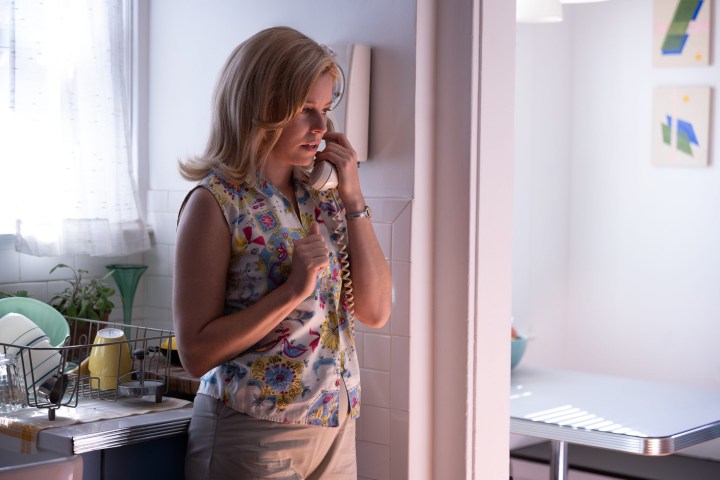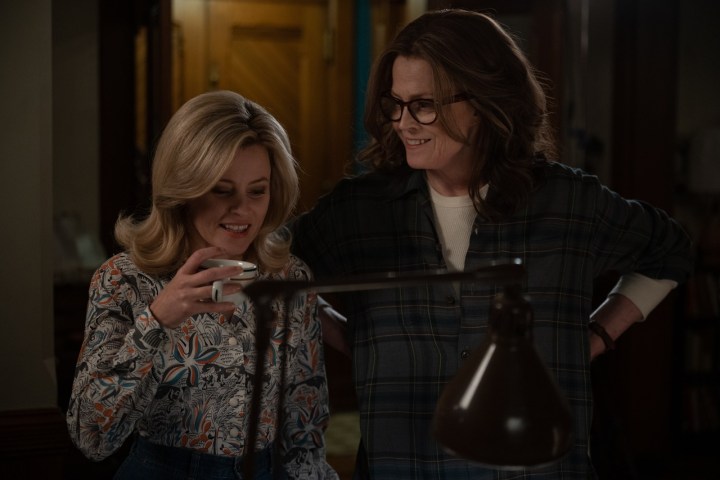“Call Jane is an entertaining and undeniably important social drama that, nonetheless, feels a bit too predictable and safe to leave the kind of lasting mark that it should.”
- An incredible true story, competently told
- Elizabeth Banks' confident, layered lead performance
- Standout supporting performances
- An abrupt ending
- A shaggy second act
- A script that feels a bit too safe
Call Jane has a habit of sneaking up on you. The new film from director Phyllis Nagy is a reproductive rights drama that, thanks to the events of this year, has become far more relevant than anyone involved could have ever predicted it would become. Despite that fact, Call Jane is a surprisingly understated, often unsentimental drama, one that prefers to lull you into its rhythms before it hits you with the power of its biggest moments or, in the case of one harrowing abortion scene, smallest details.
That approach becomes clear in Call Jane’s first scene, which follows its protagonist, Joy (Elizabeth Banks), as she quietly walks through the building where her husband, Will (Chris Messina), is celebrating his latest promotion. The film’s camera follows Joy as she descends down an escalator and then makes her way silently across the building’s ground floor to its entrance. Once outside, we’re surprised to find Joy standing behind an unwavering police line. In the distance, the sound of chanting grows increasingly louder.
We never see the riot that inevitably breaks out. Instead, all we see are the silhouettes of bodies pressing up against the frosted glass of the building’s front windows as Joy is hurriedly rushed back inside. As far as openings go, Call Jane’s introductory sequence proves to be a perfectly explosive introduction to a film that is primarily concerned with confronting, among other things, the kind of painful and celebratory truths that America’s political leaders would rather keep buried beneath the surface.

As its first scene establishes, Call Jane’s protagonist lives the kind of sheltered, traditional life that is often expected of 1960s American housewives like her. Joy’s world is turned upside down, however, when she discovers that she has a heart condition that is worsened by her own pregnancy. Joy is told there’s a high chance she’ll die if she remains pregnant, but her request for an emergency abortion is then summarily denied by the heads of her local hospital. In response, Joy begins seeking out a way for her to secure a safe abortion procedure on her own.
Her pursuit eventually leads to Joy crossing paths for the first time with the Jane Collective, a female-led underground network of women who make it their mission to provide women with illegal but safe abortions. The collective, which really operated in America throughout the late 1960s and early ’70s, is run by Virginia (Sigourney Weaver), a chill but commanding feminist. The collective provides Joy with the abortion she requires, but her relationship with the organization doesn’t end there.
Enlivened by the support and community provided by the Janes, Joy becomes increasingly embedded in their operation, even going so far as to form a relationship with the collective’s chosen doctor, Dean (Cory Michael Smith). In doing so, Joy opens the door for the Janes to become less dependent on Dean’s egotistical, financially-driven perspective toward giving women access to safe abortions. From there, Joy embarks on a rise that never feels quite as daring or provocative as it should, even though Call Jane repeatedly reminds us of the gaps that Joy’s secret life with the Janes has the potential to create between her, her husband, and her teenage daughter, Charlotte (Grace Edwards).

Despite the achievements that its female characters make throughout Call Jane’s 121-minute runtime, the film’s plot unfolds in a way that feels, at times, disappointingly straightforward and predictable. The relevance of the film’s story is undeniable, but in its attempts to normalize a topic that deserves to be discussed more openly and frankly, Call Jane ends up feeling strangely sanitized and safe. Joy’s transformation from content housewife to fierce activist goes largely unchallenged throughout the film, and while Call Jane occasionally feints at provocative detours and topics, it never fully grapples with the thorns that linger at the edges of its story.
That’s not to say that Call Jane doesn’t tell its story in a competent or compelling way. The film is, with the exception of certain shaggy sections in its second act, an engrossing and entertaining drama that moves through its story at a consistently brisk, upbeat pace. As the film’s director, Nagy makes the most out of certain sequences throughout Call Jane, including its impressive opening and the sequence in which Banks’ Joy gets her abortion. The latter scene plays out at a patient pace, one that wisely forces the viewer to sit in the room with Joy as she struggles to not let her nerves overwhelm her.
It’s in moments like that, when Joy’s toughened exterior briefly fades away, that Banks’ performance shines brightest. Opposite her, Sigourney Weaver leans all the way into her character’s chill, late-1960s hippie vibe, bringing an unwaveringly calm presence to Call Jane that acts as the perfect counterbalance to the fierce, prideful energy present in Banks’ Joy. Outside of them, Wunmi Mosaku also turns in another reliably memorable supporting performance as Gwen, the only Black member of the Jane Collective.
Ultimately, Call Jane’s impact is dulled slightly by its own limited scope, as well as its disinterest in seriously investigating the darker parts of its characters’ lives. For that reason, it’s Call Jane’s opening scene that seems to best reflect the film itself, which dazzles and entrances in parts but remains content only ever alluding to the tougher aspects of its plot. The film’s lively, infectious energy, combined with its inherent relevance, makes it well worth seeking out. Don’t be surprised, though, if you find yourself disappointed by just how non-confrontationally the film brings to life a story that could have benefitted from being told with a bit more attitude.
Call Jane is now playing in select theaters.




